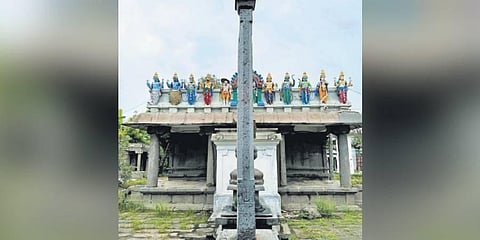

CHENNAI: Arpakkam, an ancient village, is home to the Valishwara (Siva) temple and the Adikesava Perumal (Vishnu) temple, situated close to each other. According to scholars, the Perumal temple would have been constructed in the reign of Emperor Rajaraja Chola I (985-1014 AD). The Chola inscriptions found here reveal that in those times the name of Adikesava Perumal was Thiruvira Vinnagar Azhvar. This temple is said to have once been situated in a atti vanam (forest of fig trees).
The Adikesava Perumal temple faces west with a small gopuram in front and a large vahana-mandapam outside meant for housing Perumal’s vahanas (mounts) used during festivals. The gopuram opens into the temple’s prakaram (enclosure) which has a monolithic deepa-stambham (lamp-post), dvaja-stambham (flag-post), bali-pitham and the Garuda sanctum.
A raised veranda with steps on the north and south leads to the main garbha-griha (sanctum-sanctorum) enshrining the tall image of Adikesava Perumal in a standing posture flanked by Goddesses Sridevi (Lakshmi) and Bhudevi (Goddess of the Earth) in the Kumbhakara Vimanam. He holds the Sankha and Chakra in the upper hands while the lower right hand is in abhaya hasta (blessing devotees) and lower left hand is in uru-hasta (placed on the thigh).
The utsva-murti (processional image), similar to the main one, is also worshipped as Adikesava Perumal. The dvarapalakas (door-guardians) on either side of the entrance to the principal sanctum are unique. They are made of stucco (sudhai in Tamil) and covered with organic paint (varna-kalapam). They hold the Sankha, Chakra in the upper hands, while the lower hands are in gada-hasta (placed on top of the mace) and suchi hasta (pointing). In the mandapa leading to the central sanctum is an image of Vishnu, said to be this temple’s original Perumal.
It is interesting to note that the sanctums for Goddess Lakshmi and Andal which are usually located to the right and left of the main sanctum respectively are on either side of the gopuram on the north west and south west respectively of the temple premises. Both the sanctums face east. In the inner prakaram of the Andal shrine are two images of Vira Hanuman and Bhakta Hanuman. In the outer prakaram is a separate sanctum for Vishvaksena and a four-pillar Unjal (swing) mandapam.
A few Tamil inscriptions of the Chola times have been discovered in this temple, the earliest dating to the time of Rajaraja Chola I. Others belong to the time of Rajendra Chola I (1012-1044 A.D.), Rajendra Chola II (1052-1064 AD), and chieftains like Vijaya Gandagopala and Rajanrayana Sambuvarayar. The names of two Chola queens are mentioned in these epigraphs. The utsavams (festivals) celebrated in this temple are Masi Magham, Thiruvadipuram, Krishna Jayanti, Thirukkartikai, Vaikuntha Ekadasi and Panguni Uttiram.
Temple talk
Code of worship
The rituals and festivals in this temple are according to the Vaikhanasa Agama